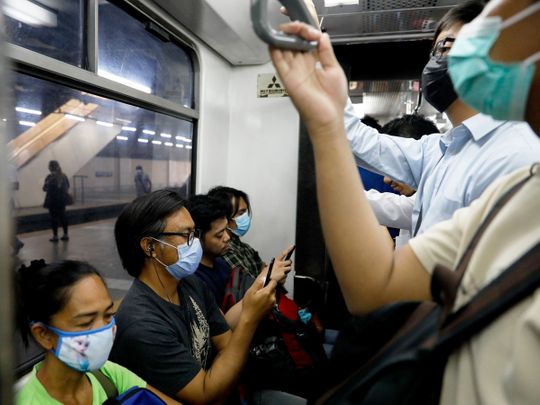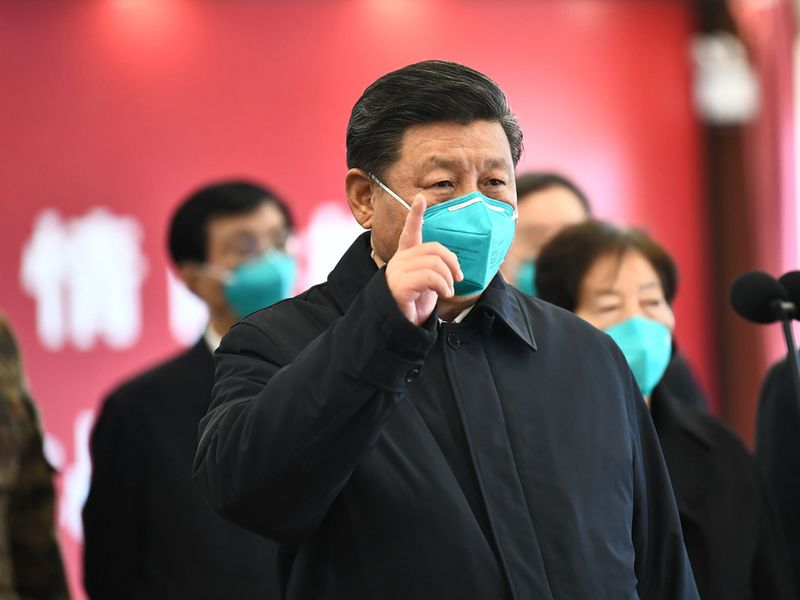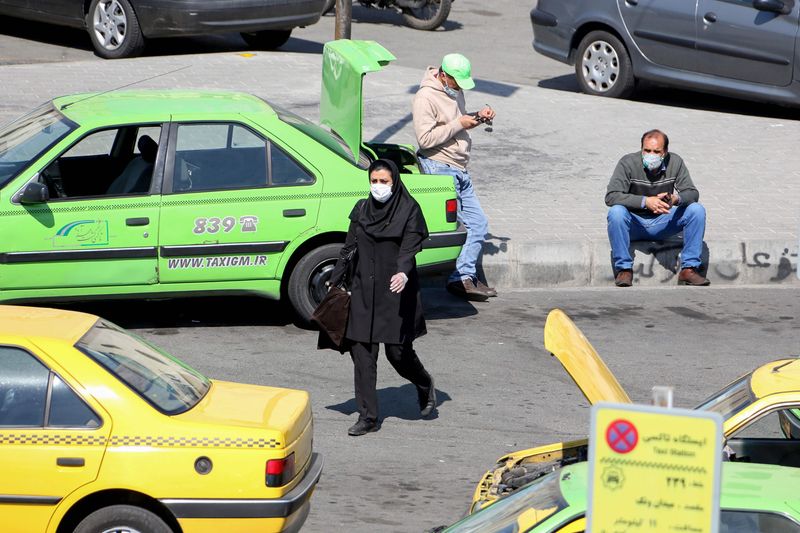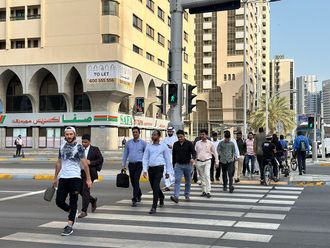
Dubai: As people across the globe look at the growing number of COVID-19 cases, now over 116,000, and the death toll of over 4,091, one key figure is being ignored - the recovery rate.
On Tuesday, China reported that a whopping 70 per cent of coronavirus cases in the country had 'recovered'.
The total global number of recoveries, at the time of publishing, stands at 64,750 with 60,113 recoveries in China alone. Iran, the worst affected in the region, reported 2,731 recoveries.
64,750
recoveries out of over 116,000 coronavirus cases worldwide
In Macao, all 10 cases reported recovered, showcasing a 100 per cent recovery rate as of March 10. Sri Lanka, Gibraltar and Nepal also reported 100 per cent recovery - one case reported and recovered for each.
China
In China, recent days have seen more recoveries than new cases. Chinese President Xi Jinping visited the coronavirus epicenter of Wuhan for the first time since the disease emerged, state media said, a trip intended to project confidence that his government has managed to stem its spread domestically.
Xi arrived Tuesday morning in the capital of hard-hit Hubei province, the official Xinhua News Agency said. Wuhan, where the disease first emerged in December, has been quarantined since January 23.

What does a COVID-19 infection look like
In most cases, a person with COVID-19 or coronavirus infection has a fever which then goes away without specific treatment. This progression is called a 'mild case' and the World Health Organization reported that nearly 80 percent of all COVID-19 cases are mild.
Most involve fever, dry cough and, in some cases, shortness of breath. People with mild cases are expected to recover without any issues, and in many cases they may not be aware they're ever sick.
A report in the Journal of the American Medical Association (JAMA) studied the COVID-19 infection in 138 patients in Wuhan and came up with the most common progression seen in cases. 99 per cent of the cases surveyed, all of whom were hospitalised at Zhongnan Hospital of Wuhan University during January had fever as a recorded symptom. Dry cough and fatigue were also common symptoms. Patients who developed complications did so within five days after they first started having the symptoms.
Age and pre-existing conditions, such as hypertension, cardiovascular disease and diabetes, increase the risk of developing complications which may lead to ICU hospitalisation.
In the cases that do get worse, pneumonia is a common ailment which then could lead to further organ dysfunction.
What aids in the recovery?
The new coronavirus has no vaccine or cure yet, but what can be attributed to the 70 per cent recovery rate then?
Nothing in particular yet, studies and accounts show, except the human immune system. Many people who recovered had mild symptoms to begin with and did not develop further complications.
She initially tested negative for the virus on her return to India from Wuhan (January 24) but later developed symptoms. The student, who preferred to withhold her name and details, said she put herself in home-quarantine despite testing negative and having no symptoms. She got her temperature recorded regularly before getting a sore throat and she alerted her local government facility (January 27).
Despite no fever at the time, she was put on antibiotics and kept in quarantine while tests were done. In 48 hours her test came back positive (January 30), by which she also had a fever. The student prescribed anti-viral drugs, Oseltamivir IP 75 mg also known by the brand name Tamiflu, for five days.
She said, "I had no diet restrictions or anything. I continued in quarantine until February 20 and was tested every alternate day. A blood, urine, stool sample and nasal or throat swab was taken and samples sent to the NIV Pune. After testing negative for nearly a week I was declared free of COVID-19 and have returned home, resumed normal life."
None of her family members or friends contracted the virus from her, she said, as she had put herself in quarantine and followed necessary protocol.
From the time she tested positive, according to her account, it was 14 days before she started testing negative for nearly one week and being declared free of the virus.
Not every recovery story is the same
In Italy, a 38-year-old man named Mattia - who is believed to be patient one in the Lombardy area - was moved out of the intensive care unit and is on the way to recovery, authorities reported on Tuesday.
At the San Matteo hospital in Pavia, there was a sigh of relief after Mattia began breathing on his own Monday with just a small amount of oxygen assistance, said Dr. Francesco Mojoli, head of intensive care. He was moved out of the ICU to a sub-ICU unit and was speaking with doctors.
"This disease has a long life,'' Mojoli told RAI state television. "Now we hope that the fact that he was young and in good shape will help him get back to his normal life.''
Mattia first went to the hospital in Codogno on February 18 complaining of flu-like symptoms. He was sent home but came back the next day after his condition worsened dramatically. He was only tested for coronavirus after doctors learned that in early February he had met with a man who had been to China.
By then, however, he had infected his wife and several doctors, nurses and patients at the Codogno hospital, creating what was thought initially to have been Italy's main cluster.
This case is an example of a case that went well over the 14-day mark due to complications and a lack of awareness. In most cases, however, 14 to 20 days is considered standard for monitoring symptoms and getting a conclusive positive/negative test.
The best route to recovery
As seen from many cases worldwide, the best way prevent infection is basic hygiene and following quarantine protocols when necessary. The best route to recovery is to depend on one's own immune system.
Following the first reported recovery in the UAE, Gulf News spoke to a specialist in internal medicine, Dr Smitha Muraletharan, from Aster Hospital in Al Ghusais, to find out how patients can be cured of coronavirus infection in general.
UAE has reported 17 recovered cases as of March 10.
“If you are healthy, you could just pass it off as a cough or cold,” Dr Muraletharan told Gulf News. “There’s no treatment or cure — just support to help your immune system clear it.”
“Patients with mild to moderate infection when detected early and isolated can get their immune system strong enough to fight the virus,” she added.
In addition to our best and only weapon as of now, the human body and nature, the world's best medical teams are working hard and fast for a gene-based vaccine against the virus.
Risk of getting COVID-19 a second time
Reuters reported that Japan reported its first case who recovered from coronavirus and then became ill with the disease for a second time. This gave way to fears of getting re-infected post recovery and questions regarding the virus's life span.
A small study out of China on four medical professionals who had the virus, published by JAMA, suggests that the new coronavirus can persist in the body for at least two weeks after symptoms of the disease clear up. All of the cases recovered, and only one was hospitalized during the illness.

Recovery is determined if tests for COVID-19 come out negative for two or more consecutive days. The cases studied in China continued to get throat swabs for the coronavirus after five days for up to 13 days post-recovery - which showed positive.
"These findings suggest that at least a proportion of recovered patients still may be virus carriers," the study concludes.
It is not uncommon for a virus to live on in the human body despite 'recovery'. Viruses such as the Zika virus, Ebola etc. tend to live on in recovered patients for months. The mono virus or the Epstein-Barr Virus can exist in the body for an entire lifespan, in most cases staying dormant and without any issues. The virus that causes chicken pox, for example, remains in your nerve tissues after infection in a dormant state.
Immunity against coronavirus
The human body's response to viruses is what is called 'immunity' where antibodies are created to recognise and destroy viruses. The reason most people are immune to chicken pox post an infection is because of the antibodies created to respond to that particular virus - varicella zoster virus - which is still in the human system but is dormant. In another example, when testing recovered cases from the 1918 Spanish flu in a 2008 paper published in Nature science journal, 90 per cent of survivors still had a high concentration of antibodies against that specific virus strain.
In the coronavirus infection, the immune system is able to create antibodies as it does with all viruses which is what ultimately results in recovery. However, factors such as the strength and longevity of these antibodies along with the mutation pattern of the virus could lead to possible relapse.
The challenge is, how fast does this mutate?
In the case of the Japanese woman who got sick again post a COVID-19 recovery, experts have various opinions.
The efficacy of antibodies created and the longevity of these is one angle.
Zhan Qingyuan, director of pneumonia prevention and treatment at the China-Japan Friendship Hospital, had warned that this could happen. "For those patients who have been cured, there is a likelihood of a relapse," Zhan said in a press briefing on January 31. "The antibody will be generated; however, in certain individuals, the antibody cannot last that long."
In another angle, experts suggested dormancy of the virus and later exacerbation.
“Once you have the infection, it could remain dormant and with minimal symptoms, and then you can get an exacerbation if it finds its way into the lungs,” Philip Tierno Jr., Professor of Microbiology and Pathology at NYU School of Medicine told Reuters.
Yet another angle is the mutation rate of the new coronavirus which is unknown as of now.
Krys Johnson, an epidemiologist at Temple University's College of Public Health told Live Science that viruses that stay behind in dormant states have a low chance of re-infection.
However, he added, there is always the possibility that the new coronavirus would mutate as it moves through populations, changing into a version that already-exposed immune systems can't recognize.
"The challenge is, how fast does this mutate?" Johnson said.
Testing for re-infection, recovery: Methods
There are many tests being researched as the best way to determine the presence of the virus. Some are very sensitive while others are not as sensitive in possibly dormant cases.
The study of the four Chinese medics with COVID-19, for example, showed positive results days after recovery from symptoms in a highly sensitive test that amplifies even the smallest viral molecule - the RT-PCR test (Reverse Transcription Polymerase Chain Reaction). This test studies RNA and DNA to analyse the presence of the virus.
In a paper published on February 26 in the Radiological Society of North America, it was found that a chest CT scan has a high sensitivity for diagnosis of COVID-19 and that it could be used as a primary tool for the current COVID-19 detection in epidemic areas.
As of now, the most common and easily accessible method of testing is the throat swab which is widely used in airports, hospitals and other quarantine facilities globally. The Centre for Disease Control (CDC) recommends four swabs daily to determine recovery.
What does a recovery mean?
When the viral load or concentration goes down in a person, so much so that his immune system is able to fight back symptoms, his throat swabs start showing low or no evidence of the COVID-19 virus. This usually happens in a span of 15-21 days. The patient is tested every alternative day until his swabs test negative for the virus. Under such circumstances the patient is said to have recovered from COVID-19.
Explaining the process, Dr Mohammad Rafique, Medical Director of Prime Hospital, Head of Infection Control and specialist pulmonologist said ‘recovery’ from COVID-19 infection did not mean one was completely virus free but the virus load had become lower and the body’s immune system had created antibodies to fight back.
“In general from studies conducted on patients one has learnt that the virus presents mild to moderate symptoms with headache, fever and cough, gastro-intestinal symptoms and so on, in younger people. Only those above 60 and with co-morbidities have severity and fatality. What makes it contagious is its high shedding rate. But when kept in isolation and with symptomatic treatment in many cases with double dose of anti-virals, the load of the virus comes down.”
Dr Rafiqe added that simple Polymerase Chain Reactor tests (PCR) records the ability of the virus to replicate. When the PCR rates fall and the virus is present in very low copies it does not show in the assay. “Naso-pharyngeal and throat swabs are taken every 24 hours and when these turn up negative, a person is said to have recovered. It means that the virus load is so low that it does not show up in the swab tests. That is when a person’s immune system has be activated creating enough anti-bodies to combat it and he or she is said to have recovered.”
Dr Satyam Parmar, head of Pathology at RAK Hospital explained : “As per the guidelines of the Centre for Disease Control, four swabs, in 24 hours gaps are taken totally from the nasopharyngeal and throat area to check if the patient has recovered.
"When all of these turn negative only then is patient declared to have recovered from COVID-19. it is advisable that a patient who has recovered must still continue to be in isolation for four to five days as his immune system has developed antibodies but the virus might still be lurking in small numbers.. This is what happens in other strains of coronavirus such as MERS and SARS,” explained Dr Parmar.
*All numbers and toll taken from https://www.worldometers.info/coronavirus/ as of 6pm on March 10.










